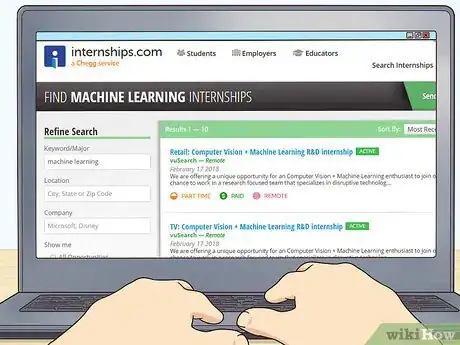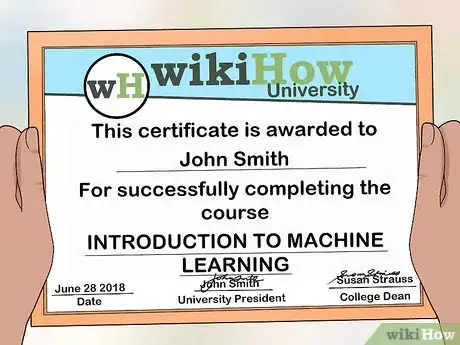This article was co-authored by Harish Chandran, PhD. Harish Chandran is the Engineering Site Lead and Senior Staff Research Engineer at DeepMind, where he leads the engineering efforts to integrate AI research results into Google products. Harish received his PhD in Computer Science from Duke University in 2012. While in graduate school, he worked as a Teaching Assistant, helping undergraduate students learn about algorithms and data structures. He has experience in DNA self-assembly, evolutionary algorithms, computational neuroscience, complexity theory, computer architecture, and super-computing.
There are 9 references cited in this article, which can be found at the bottom of the page.
This article has been viewed 75,224 times.
Machine learning engineering is a relatively new field that combines software engineering with data exploration. Though there is no single, established path to becoming a machine learning engineer, there are several steps you can take to better understand the subject and increase your chances of landing a job in the field.
Steps
Learning the Skills
-
1Learn to code using Python or a similar language. To become a machine learning engineer, you’ll need to know how to read, create, and edit computer code. Python is currently the most popular language for machine learning applications, but a significant amount of engineers use script formats like R, C, C++, Java, and JavaScript instead.[1]
- Try learning multiple languages to make yourself a more appealing job candidate.
-
2Work through online data exploration courses. Before you learn skills specific to machine learning, it’s important to have a solid foundation in data analysis. This includes subjects like statistics, which will help you understand data sets, and feature engineering, which will help you make data-based algorithms. Some high-quality online courses related to these subjects include:[2]
- Intro to Descriptive Statistics from Udacity, which will teach you how to communicate information about data sets.
- Intro to Inferential Statistics from Udacity, which will teach you how to understand and analyze data sets.
- Getting and Cleaning Data from Johns Hopkins University, which will teach you how to obtain and optimize data sets.
- Feature Engineering for Machine Learning from Udemy, which will teach you how to process and manipulate data variables.
Advertisement -
3Complete online courses related to machine learning. Once you know how to code and understand the foundational principles behind data exploration, start digging into the world of machine learning. This includes subjects like creating algorithms, implementing neural networks, and designing machine learning systems. As a starting point, look into online courses like:[3]
- Machine Learning from Stanford, an introductory class focused on breaking down complex concepts related to the field.
- Learning from Data from Caltech, an introductory class focused on mathematical theory and algorithmic application.
- Practical Machine Learning from Johns Hopkins University, a class focused on data prediction.
- Deep Learning Specialization from Coursera, a class focused on creating neural networks.
-
4Earn a relevant certification or degree to help you land a job. In engineering, many people get high-quality jobs without a formal education. However, accreditations will make you a more valuable job candidate and, in some cases, will be the only way to fulfill a company’s job requirements. To boost your chances of landing a machine learning position, work toward things like:[4]
- Online Nanodegrees in computer science, engineering, and machine learning.
- A Certificate in Machine Learning from the University of Washington.
- An Artificial Intelligence Graduate Certificate from Stanford.
- A Certification of Professional Achievement in Data Science from Columbia University.
- A CSCI E-81 Machine Learning and Data Mining certification from Harvard.
- A traditional undergraduate or graduate degree in computer science or engineering.
Gaining Experience
-
1Work on personal machine learning projects. When you’re first starting out, try examining and recreating basic projects provided by Scikit-learn, Awesome Machine Learning, PredictionIO, and similar resources. Once you have a solid grasp on how machine learning works in practice, try coming up with your own projects that you can share online or list on a resume.[5]
- So you don’t have to spend time collecting data, try using publicly available data sets from places like the UCI Machine Learning Repository and Quandl.[6]
- If you can’t come up with a project idea, look for inspiration on websites like GitHub.
-
2Participate in Kaggle knowledge competitions. Kaggle is a dataset database that hosts a variety of machine learning challenges. Some of these are official competitions, which offer monetary prizes, and some are free competitions that simply provide experience.[7]
- To start out, try completing the beginner competition Titanic: Machine Learning from Disaster.
-
3Apply for a machine learning internship. While personal projects and competitions are fun and look great on a resume, they may not teach you the business-specific machine learning skills required by many companies. So you can gain this experience, look for internships or entry-level jobs related to product-focused machine learning.
- Look for relevant internships on websites like Internships.com.
Acquiring a Machine Learning Job
-
1Look for machine learning jobs online. You can find current job openings on classified websites like ZipRecruiter, Glassdoor, and Indeed. Though many companies use the position title Machine Learning Engineer, some may use alternate titles like:
- Data Scientist
- AI Engineer
- Big Data Engineer
- Deep Learning Engineer.
-
2Write a resume that highlights your machine learning skills. When creating a resume for a machine learning position, focus on things relevant to the field such as your professional experience and educational accreditations. For any previous jobs, make sure to list specific things you accomplished related to machine learning.[8]
- If you completed any job-relevant personal projects, feel free to list them on your resume using short, sentence-long descriptions. If possible, include a link to the project so the company can see it.
-
3Create a personalized cover letter for each position you apply to. On every cover letter, list your job qualifications, education, and relevant experience. To personalize your letters, include a unique sentence or 2 in each about what you’ll bring to the company you’re applying to.[9]
- Your cover letters should be no more than 3 paragraphs long.
-
4Submit the job application. To apply for an engineering position, fill out the official job application provided by the organization in question. Then, submit the application using whatever method they require. Don’t forget to attach your resume, cover letter, and any other requested documents!
- Since machine learning positions are tech-based, expect to fill out most of your applications electronically.
- Before submitting your application, check it thoroughly for any spelling or grammar mistakes.
Working as a Machine Learning Engineer
-
1Create and run machine learning experiments. As a machine learning engineer, you’ll be tasked with solving specific problems using your employer’s internal data. To do this, you’ll need to come up with and test out various experimental algorithms that yield results relevant to the task at hand.[10]
-
2Build and implement machine learning systems. Once you come up with a good algorithm, you’ll have to create a machine learning system that can run it automatically. Depending on the task at hand, your algorithm may operate on its own or it may interact with the organization’s existing digital systems.[11]
-
3Ensure the data pipelines run smoothly. In addition to the more creative aspects of machine learning, you’ll have to manage the infrastructure that makes your engineering operations possible. It will be your job to ensure that data gets from 1 point to another without running into any trouble.[12]
-
4Participate in educational programs to earn promotions. Once you’ve established yourself with a company, you may reach a pay ceiling based on your current education level. To gain additional raises and promotions, you may have to get a machine learning certification, earn a degree, or participate in specialty courses.
- Some companies will fund your additional education, though others will require you to pay out of pocket for it.
Expert Q&A
Did you know you can get expert answers for this article?
Unlock expert answers by supporting wikiHow
-
QuestionWhat skills do you need for machine learning?
 Harish Chandran, PhDHarish Chandran is the Engineering Site Lead and Senior Staff Research Engineer at DeepMind, where he leads the engineering efforts to integrate AI research results into Google products. Harish received his PhD in Computer Science from Duke University in 2012. While in graduate school, he worked as a Teaching Assistant, helping undergraduate students learn about algorithms and data structures. He has experience in DNA self-assembly, evolutionary algorithms, computational neuroscience, complexity theory, computer architecture, and super-computing.
Harish Chandran, PhDHarish Chandran is the Engineering Site Lead and Senior Staff Research Engineer at DeepMind, where he leads the engineering efforts to integrate AI research results into Google products. Harish received his PhD in Computer Science from Duke University in 2012. While in graduate school, he worked as a Teaching Assistant, helping undergraduate students learn about algorithms and data structures. He has experience in DNA self-assembly, evolutionary algorithms, computational neuroscience, complexity theory, computer architecture, and super-computing.
Machine Learning Engineer & PhD in Computer Science, Duke University Machine Learning Engineer & PhD in Computer Science, Duke UniversityExpert AnswerMath, statistics, and coding are all helpful for a career in machine learning. Programming is a vital component of working with machine learning, and you'll also need to have a good grasp of statistics and linear algebra. When you're ready to dig further into machine learning, read the textbook Deep Learning by Ian Goodfellow. You can also get into practical coding with a platform like Kaggle, but I recommend really studying the basics before you jump into that. Otherwise, you're solving problems without understanding why things work the way they do.
Machine Learning Engineer & PhD in Computer Science, Duke UniversityExpert AnswerMath, statistics, and coding are all helpful for a career in machine learning. Programming is a vital component of working with machine learning, and you'll also need to have a good grasp of statistics and linear algebra. When you're ready to dig further into machine learning, read the textbook Deep Learning by Ian Goodfellow. You can also get into practical coding with a platform like Kaggle, but I recommend really studying the basics before you jump into that. Otherwise, you're solving problems without understanding why things work the way they do. -
QuestionWhat is machine learning?
 Harish Chandran, PhDHarish Chandran is the Engineering Site Lead and Senior Staff Research Engineer at DeepMind, where he leads the engineering efforts to integrate AI research results into Google products. Harish received his PhD in Computer Science from Duke University in 2012. While in graduate school, he worked as a Teaching Assistant, helping undergraduate students learn about algorithms and data structures. He has experience in DNA self-assembly, evolutionary algorithms, computational neuroscience, complexity theory, computer architecture, and super-computing.
Harish Chandran, PhDHarish Chandran is the Engineering Site Lead and Senior Staff Research Engineer at DeepMind, where he leads the engineering efforts to integrate AI research results into Google products. Harish received his PhD in Computer Science from Duke University in 2012. While in graduate school, he worked as a Teaching Assistant, helping undergraduate students learn about algorithms and data structures. He has experience in DNA self-assembly, evolutionary algorithms, computational neuroscience, complexity theory, computer architecture, and super-computing.
Machine Learning Engineer & PhD in Computer Science, Duke University Machine Learning Engineer & PhD in Computer Science, Duke UniversityExpert AnswerMachine learning is essentially the process of using examples to teach computers to recognize patterns of data. It's a technique called supervised learning. For example, if you want to create a system that can distinguish between pictures of foods, then you compile thousands of pictures of bananas, oranges, and apples, and label them all. Then, the machine tries to recognize that those images correspond to those particular labels.
Machine Learning Engineer & PhD in Computer Science, Duke UniversityExpert AnswerMachine learning is essentially the process of using examples to teach computers to recognize patterns of data. It's a technique called supervised learning. For example, if you want to create a system that can distinguish between pictures of foods, then you compile thousands of pictures of bananas, oranges, and apples, and label them all. Then, the machine tries to recognize that those images correspond to those particular labels. -
QuestionHow do I start a career in machine learning?
 Harish Chandran, PhDHarish Chandran is the Engineering Site Lead and Senior Staff Research Engineer at DeepMind, where he leads the engineering efforts to integrate AI research results into Google products. Harish received his PhD in Computer Science from Duke University in 2012. While in graduate school, he worked as a Teaching Assistant, helping undergraduate students learn about algorithms and data structures. He has experience in DNA self-assembly, evolutionary algorithms, computational neuroscience, complexity theory, computer architecture, and super-computing.
Harish Chandran, PhDHarish Chandran is the Engineering Site Lead and Senior Staff Research Engineer at DeepMind, where he leads the engineering efforts to integrate AI research results into Google products. Harish received his PhD in Computer Science from Duke University in 2012. While in graduate school, he worked as a Teaching Assistant, helping undergraduate students learn about algorithms and data structures. He has experience in DNA self-assembly, evolutionary algorithms, computational neuroscience, complexity theory, computer architecture, and super-computing.
Machine Learning Engineer & PhD in Computer Science, Duke University Machine Learning Engineer & PhD in Computer Science, Duke UniversityExpert Answer
Machine Learning Engineer & PhD in Computer Science, Duke UniversityExpert Answer
References
- ↑ https://www.infoworld.com/article/3186599/artificial-intelligence/the-5-best-programming-languages-for-ai-development.html
- ↑ https://www.analyticsvidhya.com/learning-path-learn-machine-learning/
- ↑ https://www.analyticsvidhya.com/learning-path-learn-machine-learning/
- ↑ https://www.analyticsvidhya.com/blog/2015/08/data-science-bootcamps-machine-learning-certifications/
- ↑ https://www.kdnuggets.com/2015/12/top-10-machine-learning-github.html
- ↑ https://www.dataquest.io/blog/free-datasets-for-projects/
- ↑ https://www.kaggle.com
- ↑ https://uhr.rutgers.edu/worklife-balance/life-events/layoff-information/preparing-resume-and-cover-letter
- ↑ https://uhr.rutgers.edu/worklife-balance/life-events/layoff-information/preparing-resume-and-cover-letter
- ↑ https://engineeringonline.ucr.edu/resources/article/an-engineers-role-in-machine-learning/
- ↑ https://engineeringonline.ucr.edu/resources/article/an-engineers-role-in-machine-learning/
- ↑ https://www.forbes.com/sites/adelynzhou/2017/11/27/artificial-intelligence-job-titles-what-is-a-machine-learning-engineer/#356661f84c7d
About This Article
To become a machine learning engineer, first learn how to code in a language relevant to the field, such as Python. Make use of online machine learning courses to gain knowledge about the field, and consider getting a certification or degree to become a more valuable candidate. Once you have a basic skill set, gain experience by applying for a machine learning internship, participating in Kaggle competitions, and completing personal engineering projects. For advice on how to get a job as a machine learning engineer, scroll down!










































































